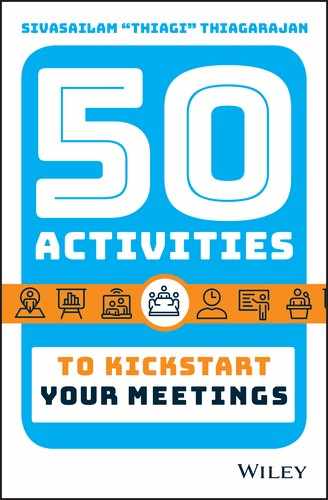21
$20 AUCTION
I have been facilitating this activity for over a decade. I originally conducted it as “$1 Auction,” but I have now made adjustments for inflation.
Synopsis
Auction off a $20 bill with the following rules: highest bidder pays the amount bid and receives the bill. The second highest bidder also pays the amount bid—and does not receive anything in return.
Purpose
To explore factors related to the escalation of interpersonal conflicts
Participants
Minimum: 2
Maximum: Any number
Best: 5–10
Time
5–15 minutes
Supplies and Equipment
A $20 bill (or a suitable bill in the local currency)
Flow
Brief the participants. Hold up a $20 bill (or a suitable bill in the local currency) and explain that you are going to auction it off. Ask participants to listen carefully as you explain the following rules in your own words:
- The first bid should be $10.
- All subsequent bids should be in $1 increments.
- You should not skip any increment. (For example, after someone bids $13, the same person may not jump to $14.)
- When the bidding stops, the highest bidder pays the amount bid and receives the $20.
- When the bidding stops, the second highest bidder also pays the amount bid—and receives nothing in return. (For example, if Diane bids $18 and Jonathan bids $19 and if the bidding stops there, Jonathan pays $19 and gets $20. Diane pays $18 and gets nothing.)
Start the auction. The first few bids tend to clump together. Bids will slow down around $15. The bidding will become limited to two participants around this time.
Encourage continuous bidding. After the bid of $19, wait for a moment to see if the momentum carries the other bidder forward. If there is a pause, remind the person who made the $18 bid that the rules do not prohibit bids of $20 or more. Usually the bidders will figure out that bidding more than $20 saves money (!).
Conclude the auction. Stop when one bidder gives up. Collect the money from the top two bidders and give the $20 bill to the highest bidder. (Return the money to the bidders after the debriefing discussion, but for now maintain the illusion that you are serious.)
Conduct a debriefing discussion. Ask the participants to guess why some people bid more than $20 for the $20 bill. Also ask them if this activity reminds them of events in their workplace.
Link to the Meeting
Explore the sunk-cost fallacy. Explain that this activity was originally created by economist Martin Shubik to illustrate how a series of rational choices may ultimately lead to irrational decisions. The original bidders attempt to reduce their loss by bidding one more dollar. This logical choice eventually leads to reckless bidding.
Ask the participants to relate the “$20 Auction” to the participants’ behavior in meetings when they persist on wasting time in unnecessary conflicts. Encourage the participants to avoid such behaviors during the ensuing meeting.
